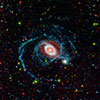Feature Story
GALEX Gauges a Galaxy's Growing Pains
When Dr. David Thilker of Johns Hopkins University, Baltimore, Md., looked at an image of nearby spiral galaxy NGC 2841 taken by the panoramic ultraviolet eyes of NASA's Galaxy Evolution Explorer (GALEX), it first seemed the scale of the image was incorrect. Then, he realized something far more interesting was happening.
"This particular galaxy's disk looks more than three times bigger in our sensitive GALEX ultraviolet observations than it does in visible-light," said Thilker.
He believes the excess comes from new star formation occurring in an unexpected area outside of the galaxy's dense main disk where most of its stars live. According to Thilker, up to 20 percent of all nearby galaxies observed with GALEX show some degree of this ultraviolet excess, which scientists call an "extended ultraviolet disk".
Astronomers suspect this excess light may offer valuable insights into the mystery of how galaxies grow and how our universe' first stars formed.
"Few telescopes have the wide view to study the peripheral environments of nearby galaxies, so there is not very much known about these regions," said Dr. Armando Gil de Paz, of the Universidad Complutense de Madrid, Spain.
"GALEX was the first telescope to see an extended UV disk. Its unique ultraviolet range and wide field of view make it an excellent tool to study the extended features of nearby galaxies," added Thilker.
SNAPSHOTS OF GROWING GALAXIES
Currently, nobody knows precisely why galaxies look the way they do. How modern galaxies got their shapes, sizes, and colors has been a focus of astronomical research ever since galaxies were first discovered.
According to one widely accepted astronomical model, galaxies grow from the inside out - meaning that a galaxy's first stars form near its center, and subsequent generations of stars form along the edge of that galaxy's disk. Now, astronomers suspect that GALEX images of extended ultraviolet disks are providing observational evidence confirming that this is indeed how galaxies grow.
The extended disk consists of faint ultraviolet emission from newly forming stars. In most galaxies, the extended disk continues the structure of the galaxy's well-defined spiral arms, which consists of both old and young stars. It is this older stellar population that astronomers see in visible-light images, and what they consider to be the galaxies "main disk." The key difference between a galaxy's main and extended disk is the relative scarcity of older stars in the outer disk.
According to Gil de Paz, the stars in the extended ultraviolet disks observed by GALEX all formed relatively recently, less than one billion years ago. In comparison, our Earth is about 4.5 billion years old and the universe is approximately 14 billion years old.
"The timescale for this extended star formation is very short," said Gil de Paz. "Many galaxies across the universe may have already passed this extended UV disk phase, and perhaps the stars now seen in their main disk formed in a extended UV disk."
"By imaging extended UV disks, GALEX provides us with snapshots of the galaxy formation process and shows what may have happened in all spiral galaxies at any earlier epoch," added Thilker.
NOT YOUR TYPICAL STAR FORMING ENVIRONMENT
In addition to insights about galactic growth, astronomers are also learning a lot about star formation from extended ultraviolet disks.
Like raindrops, scientists usually see stars form when dense patches of gas and dust collapse under immense pressure deep inside a cosmic cloud.
According to Thilker, the extended ultraviolet disk environment is very different from the typical star-forming environments previously observed by astronomers. He notes that gas in the extended disk is more diffuse overall, in comparison to the main disk, and that the dense gaseous condensations needed for star formation become progressively rare.
"Before GALEX, astronomers would have considered a cosmic environment with such low gas density a relatively unlikely site for star formation, but evidently the conditions do allow some clouds to collapse," said Thilker.
"The UV observations now show that star formation in this type of environment is surprisingly common. This finding will give astronomers across the field a better idea of the threshold conditions necessary for star formation," he added.
So far, astronomers have found extended ultraviolet disks mainly around interacting galaxies, leading Thilker and Gil de Paz to suspect that shockwaves from the interaction are triggering star formation in the outskirts of the galaxies. However, both note that this notion is still very controversial and more research needs to be done.
"Another interesting aspect of the extended UV environment is that it is relatively unpolluted," said Gil de Paz.
Unlike most modern star formation regions inside dense clouds of gas and dust, Gil de Paz believes the extended disk area lacks, or is relatively "unpolluted," by many chemical elements heavier than hydrogen and helium.
Because most chemical elements beyond hydrogen and helium are created by stars, astronomers believe the relatively pristine environment of an extended ultraviolet disk will provide insights into the conditions from which the universe' first stars formed.
"Usually astronomers think that there is not much going on beyond the galaxy's main disk, but GALEX is showing that the area beyond the main disk is really dynamic," said Thilker.




